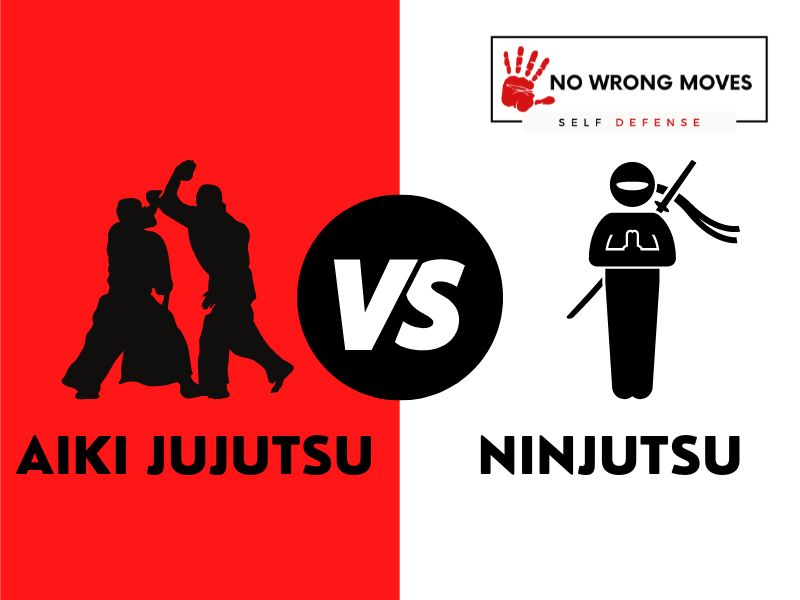
- What We Know About Aiki Jujutsu
- What We Know About Ninjutsu
- Key Elements Of Aiki Jujutsu
- Key Elements Of Ninjutsu
- Aiki Jujutsu Rankings & Levels
- Ninjutsu Rankings & Levels
- Aiki Jujutsu Vs. Ninjutsu Attire
- What A Typical Aiki Jujutsu Training Session Looks Like
- What A Typical Ninjutsu Training Session Looks Like
- Aiki Jujutsu Movies
- Conclusion: Aiki Jujutsu Vs. Ninjutsu
Today, we are going to end the long-standing debate of Aiki Jujutsu Vs. Ninjutsu! People (especially those online) go back on forth on which discipline is better.
Some say that Aiki Jujutsu is more fluid and instinctive, while others argue that Ninjutsu is more powerful and straightforward. So which is it, and why?
Well...
The main difference between Aiki Jujutsu and Ninjutsu is that Aiki Jujutsu focuses on using the opponent's energy against them, while Ninjutsu focuses on using stealth and speed to avoid or strike the opponent.
While both are Japanese martial arts, they have different origins and styles. Aiki Jujutsu dates back to the feudal era of Japan, where it was used by the Samurai class.
The art was passed down from generation to generation, and eventually became its own distinct style. Ninjutsu, on the other hand, originated with the Ninja warriors of feudal Japan.
The Ninja were a covert group of assassins and spies, and as such, their martial art focused on techniques that would give them an advantage in stealth and speed.
Today, both Aiki Jujutsu and Ninjutsu are practiced around the world by martial arts enthusiasts. While they share some similarities, the two styles remain distinct in their focus and approach.
What We Know About Aiki Jujutsu
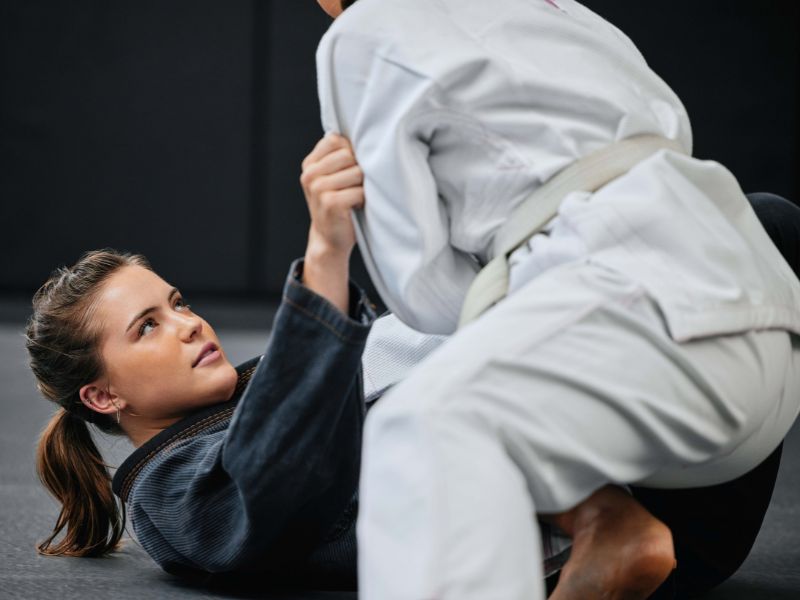
Aiki Jujutsu is a martial art that involves harmonizing your own energy with that of your opponent in order to redirect it in a way that suits your needs.
Instead of meeting force head-on, Aiki Jujutsu practitioners use Kempo-Jutsu's striking and evasive techniques to position themselves close to their opponents. They then follow up with linear, diagonal, or circular movements to redirect the opponent's energy.
Throwing techniques in Aiki Jujutsu rely heavily on Kempo-Jutsu's Atemi. In some instances, a skilled practitioner can apply Aiki Jujutsu throwing techniques by blending with their opponent's energy.
Aiki Jujutsu can be traced back to the Takenouchi Hisamori's Shinmei-ryu school of swordsmanship, which he founded in the early 1600s.
His student, Takeda Sokaku, is credited with creating Aiki Jujutsu from the techniques he learned from Hisamori. Sokaku passed on his knowledge to his son, Takeda Tokimune, who then continued to develop and teach the art until his death in 1943.
The art was further refined by Morihei Ueshiba, who created Aikido, a modernized version of Aiki Jujutsu.
Even today, Aiki Jujutsu can be used for self-defense or as a form of physical and mental exercise. Its excellent teachings regarding control over one's body and mind have made it a staple in the martial arts community.
What We Know About Ninjutsu

Ninjutsu is a martial art that originated in Japan. It is known for its stealthy techniques and use of unorthodox weapons. Ninja were traditionally associated with espionage and assassination, but today ninjutsu is practiced as a form of self-defense and exercise.
Ninjutsu training typically includes activities such as juggling, jumping, running, and rolling. Students also learn to use various props such as sticks, swords, and nunchaku. In addition to physical conditioning, ninjutsu also requires mental discipline and focus.
Students must be able to control their breath and stay calm under pressure. Ninjutsu is a demanding art, but it can be extremely rewarding for those who are willing to put in the effort.
Of course, this is only a brief history and understanding of Aiki Jujutsu and Ninjutsu, but if you want to go deeper into either art, be sure to check out the following posts:
Now, back to the comparison...
Let's look at the origins of the respective disciplines and then compare the key elements of their practices. You will be able to understand some of their similarities and differences a bit better afterward.
| Aiki Jujutsu | Ninjutsu | |
| Origins | Japanese | Japanese |
Key Elements Of Aiki Jujutsu
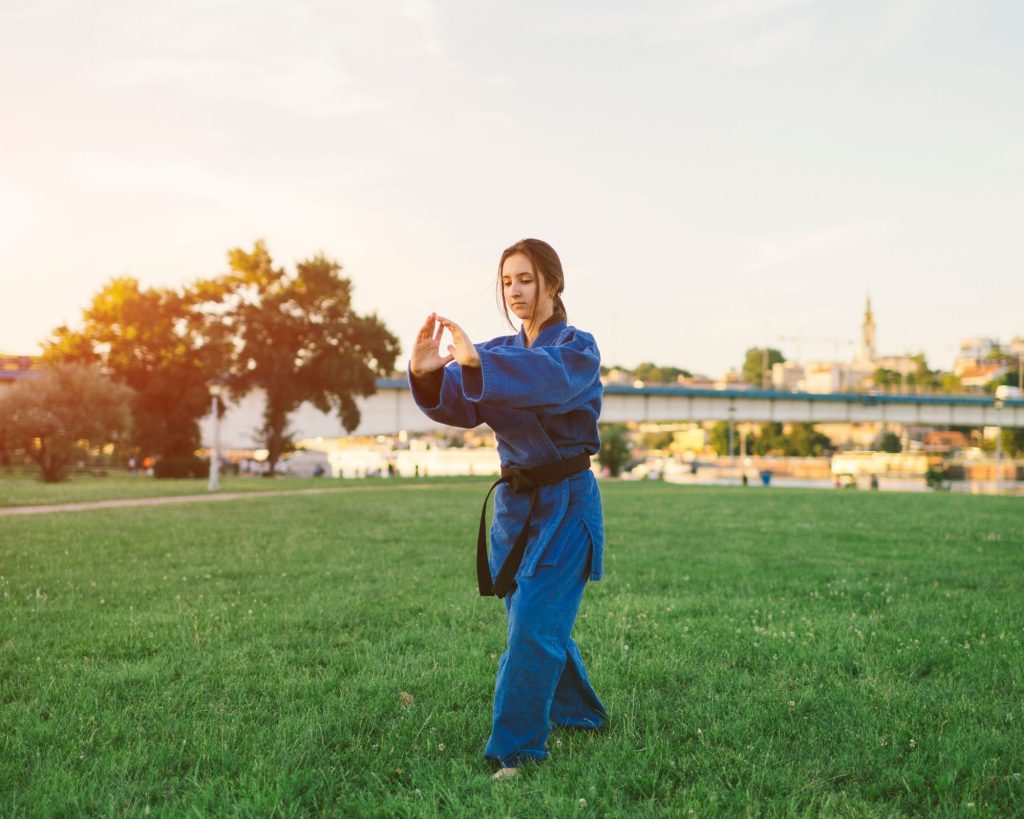
One of the fundamental principles in Aiki Jujutsu is the use of leverage and balance to gain an advantage over one's opponent. This involves the strategic application of force and momentum to manipulate an opponent's body, making it easier to control and overpower them.
Another essential component of Aiki Jujutsu is the use of body movement and positioning.
By carefully positioning one's body in relation to the opponent, a practitioner can create openings for attacks or defensive maneuvers. This requires a high degree of spatial awareness and precision in movement.
Joint locks and throws are powerful techniques that can be used to subdue an opponent quickly and efficiently.
These maneuvers involve applying pressure to a joint or manipulating an opponent's balance to throw them to the ground. They require a thorough understanding of anatomy and a high degree of technical skill.
One of the most advanced techniques in Aiki Jujutsu is the ability to blend with the motion of an attacker. This involves moving in a way that allows a practitioner to avoid incoming attacks while simultaneously positioning themselves to counterattack.
It requires an acute awareness of an opponent's movements and a high level of skill in evasive maneuvers.
Next, up here in Aiki Jujutsu is breath control. By learning to regulate their breathing, practitioners can maintain their focus and energy levels, even in the face of physical exertion and stress.
Mental focus and calmness in the face of adversity are critical traits for any Aiki Jujutsu practitioner.
And speaking from personal experience, if you're knee deep into a fight, you'll want to know how to maintain a clear head and a calm demeanor, even in the face of obvious danger.
This requires mental fortitude and the ability to stay focused under pressure, the kind that Aiki Jujutsu will teach you.
Finally, one of the most powerful parts of this martial art is its ability to use an attacker's energy against them.
By skillfully redirecting an opponent's momentum, a practitioner can use their strength and force to overpower them. Of course, this requires a deep understanding of the techniques and a high degree of technical skill--which, trust me, your training will be able to give you in spades.
Key Elements Of Ninjutsu
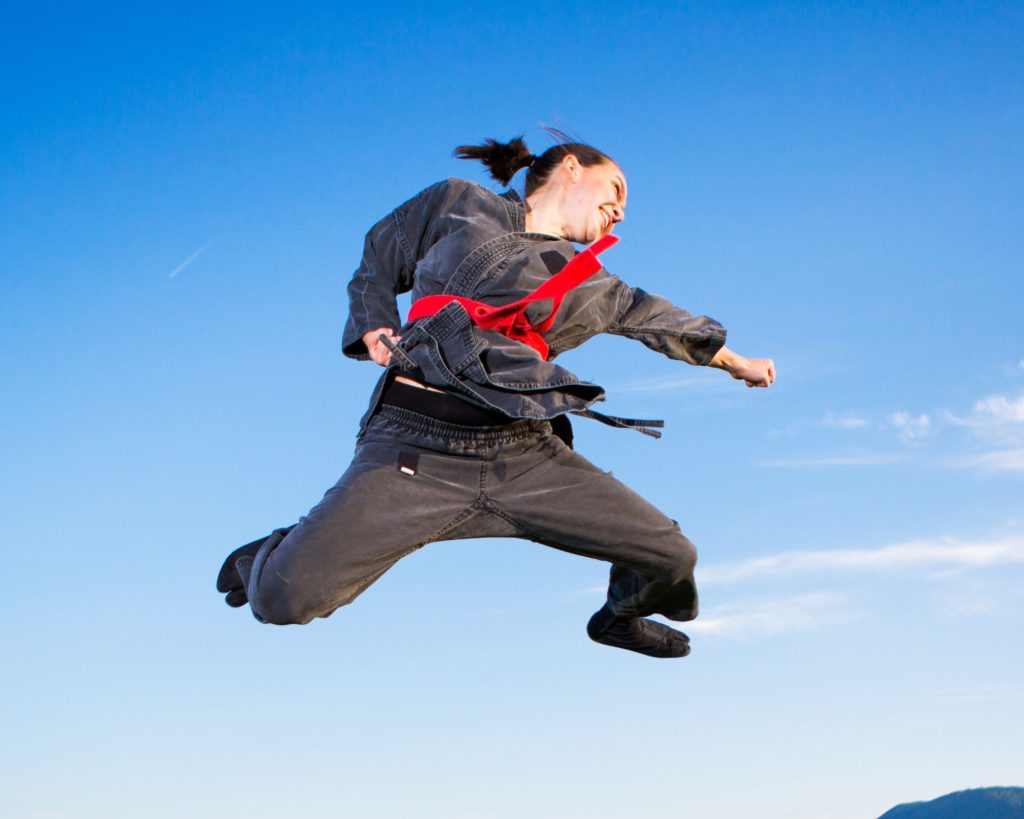
Ninjutsu is a comprehensive system of martial arts that teaches methods of unarmed combat, weapon use, espionage, and sabotage.
It employs a wide variety of weapons and tactics, making use of whatever is available in order to achieve the desired outcome.
Ninjutsu is known for its quick and agile movements, as well as its effective use of evasion and distraction techniques. It relies heavily on mind-body coordination and discipline, requiring practitioners to be both physically and mentally agile.
5. Ninjutsu training can be quite rigorous, and requires a high level of dedication and commitment.
Ninjutsu also teaches mental discipline and focus, as well as the use of various secret weapons and tools. These elements are important because they allow practitioners to effectively defend themselves against physical attacks while also remaining hidden and undetected.
Another thing I think is important to look at is the different rankings and levels in each art. if you are looking to take up either Aiki Jujutsu or Ninjutsu, whether as a hobbyist or to compete, you need to understand the different levels of proficiency and what is required for testing and ranking.
Aiki Jujutsu Rankings & Levels

Aiki Jujutsu has its own ranking system, as you've likely already expected. It starts with the 10th Kyu white belt, which represents the beginner level. As one progresses, they move up the ranking system by earning colored belts and stripes.
The ranking system is divided into two categories: kyu and dan. Kyu represents the colored belts that one earns before reaching the black belt level. Dan represents the black belt levels.
The colored belt levels range from 9th Kyu white belt with a yellow stripe, all the way to 4th Kyu purple belt.
The amount of training required to earn these belts is pretty significant, in my opinion. IT ranges from 2 to 3 months, such as for the 9th Kyu white belt with a yellow stripe, to 15 to 21 months, like for the 4th Kyu purple belt.
The black belt levels start with the Shodan-Ho (Junior Black Belt) and progress to the highest level, which is the Godan (5th Degree Black Belt).
If you ask me, it's definitely not an easy feat to achieve: it normally takes years of dedication and training to reach the highest levels of the black belt ranking system.
If this is all a bit hard to visualize, don't worry; I've made a more detailed breakdown for you to see below:
| Rank | Color |
| 10th Kyu | White |
| 9th Kyu | White |
| 8th Kyu | Yellow |
| 7th Kyu | Blue |
| 6th Kyu | Green |
| 5th Kyu | Green |
| 4th Kyu | Purple |
| 3rd Kyu | Brown |
| 2nd Kyu | Brown |
| 1st Kyu | Brown |
| Shodan-Ho | Black |
| Shodan | Black |
| Nidan | Black |
| Sandan | Black |
| Yondan | Black |
| Godan | Black |
Ninjutsu Rankings & Levels

The Ninjutsu Kyu Rank System is a ranking system used in the martial art of Ninjutsu. The system has nine ranks, with each rank corresponding to a level of ability. The ranks are as follows:
The Kyu 1 rank is the entry-level rank, and indicates that the practitioner has a basic understanding of the art of ninjutsu.
The Kyu 2 rank indicates that the practitioner has a more advanced understanding of the art, and can begin to learn more complex techniques.
The Kyu 3 rank is the beginning of the intermediate level, and indicates that the practitioner has mastered some basic techniques and is able to start learning more complex ones.
The Kyu 4 rank is an advanced level, and indicates that the practitioner has mastered many basic techniques and is able to apply them in combat.
The Kyu 5 rank is an even more advanced level, and indicates that the practitioner has mastered all basic techniques and is able to apply them in any situation.
The Kyu 6 rank is the beginning of the expert level, and indicates that the practitioner has reached a high level of mastery over ninjutsu.
The Kyu 7 rank is an even higher level, and indicates that the practitioner has mastered all techniques and is able to use them in any situation.
The Kyu 8 rank is the highest rank in the system, and indicates that the practitioner has reached an unsurpassed level of mastery over ninjutsus techniques and strategies.
The Kyu 9 rank is a special rank, only given to ninjutsu masters who have trained for many years and achieved a level of mastery beyond the Kyu 8 rank.
The ranking system is used as a way to track a practitioner's progress and ability in the art of ninjutsu.
Aiki Jujutsu Vs. Ninjutsu Attire
This section simply compares the clothing and uniforms that practitioners wear in combat.
Aiki Jujutsu Attire:
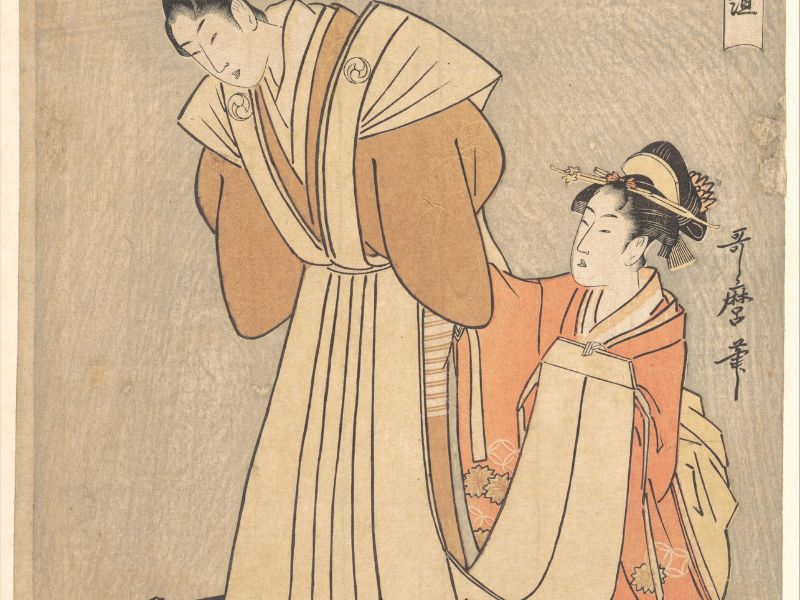
In terms of attire, Aiki Jujutsu practitioners typically wear a traditional dogi and hakama. This affords them better gripping and movement during techniques.
Ninjutsu Attire:
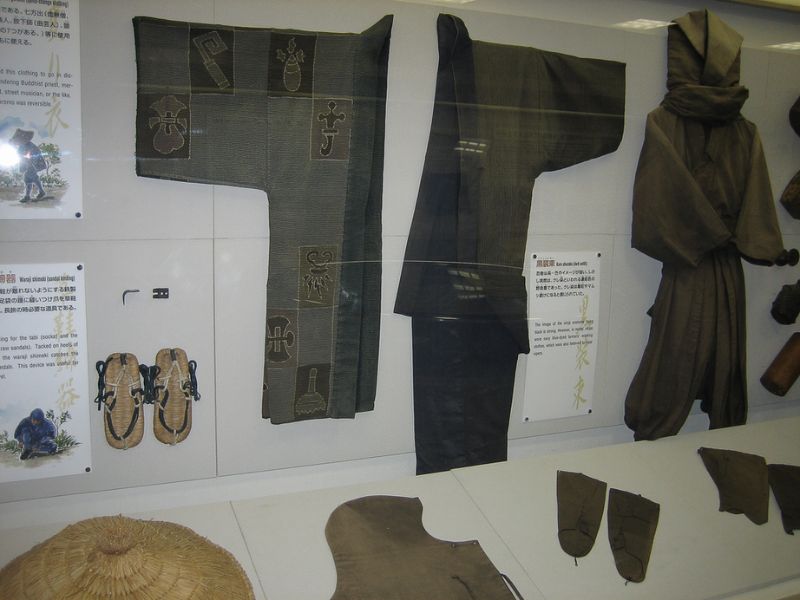
One aspect of traditional Japanese ninjutsu is the attire worn by practitioners during training and infiltration missions.
The most commonly recognized piece of ninjutsu attire is the black uniform, or shikaku-gi, which helps ninja blend into the night and hide in shadows. In addition to the uniform, ninja also wear tabi socks with split toes for improved agility and stealth, as well as a hood or mask to conceal their identity.
Another important piece of ninjutsu attire is the obi, or belt. This belt not only serves a practical purpose in holding up the uniform, but it also symbolizes the ninja's rank and experience level within the tradition.
Ninja also carry various tools and weapons on their person, such as shuriken (throwing stars), kunai (multi-purpose knives), and tessen (iron fans). These items are often kept in hidden compartments within the uniform or obi.
What A Typical Aiki Jujutsu Training Session Looks Like
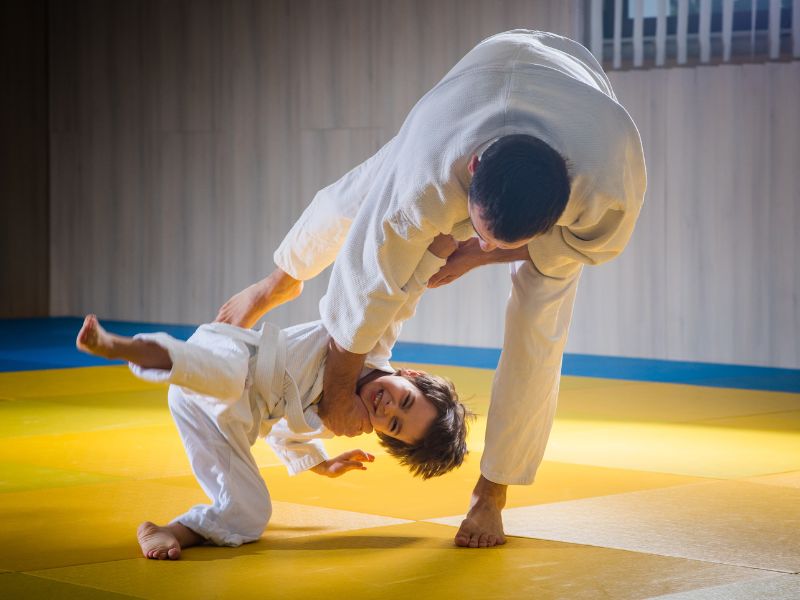
A typical Aiki Jujutsu practice session may start with a few minutes of warm-ups, such as joint rotations and light stretches. This is followed by practicing techniques, which may include throws, locks, and pins. The session usually ends with some relaxation exercises and a cool-down.
One of the most commonly used techniques in Aiki Jujutsu is the wristlock. This involves controlling an opponent's wrist and using their own momentum to throw them off balance.
In addition to physical technique, Aiki Jujutsu also emphasizes mental and spiritual development. This includes cultivating a strong mind-body connection and developing qualities such as patience and awareness.
What A Typical Ninjutsu Training Session Looks Like
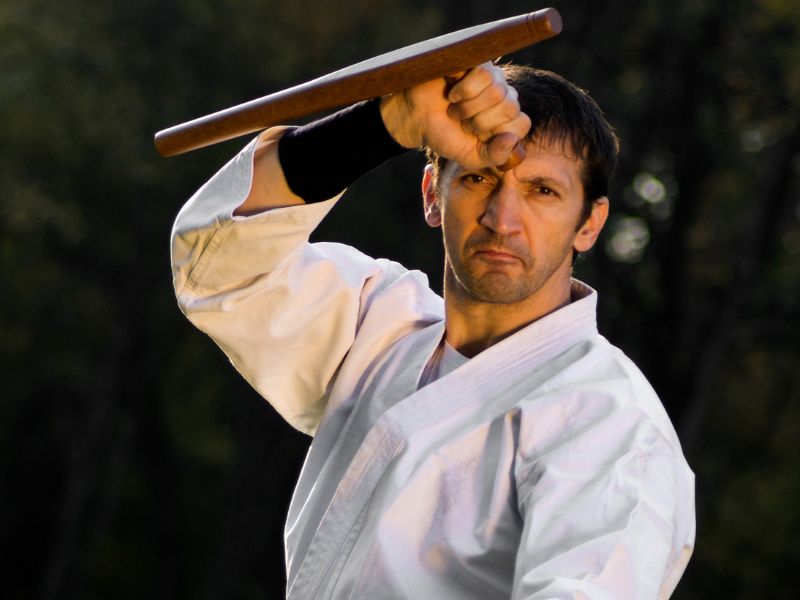
At your typical Ninjutsu beginner class, you may start with warm-up exercises and stretches. Then, the instructor may demonstrate and guide you through various techniques, such as taijutsu strikes or koppo pressure point attacks.
You may also practice stealth techniques like shinobi iri, as well as enhance your physical fitness and agility. As you learn and refine your skills, you may also begin training with traditional ninja weapons like swords or naginatas.
If the last few sections have been a bit full-on or a bit too technical, you will like this next section! Why? Because who doesn't love a good martial arts flick?
Both Aiki Jujutsu and Ninjutsu have been featured in a number of films and TV shows, so if you want to learn more about them, then entertain yourself with the following 👊
Aiki Jujutsu Movies

These are some of my favorite movies and shows with Aiki Jujutsu in them:
- The Bourne Identity (2002)
- Kill Bill: Volume 1 (2003)
- The Protector (2005)
- The Matrix Reloaded (2003)
- 13 Assassins (2010)
- The Raid (2011)
Some movies that have Ninjutsu in them that you may not even have noticed...
- The Last Samurai (2003)
- Ninja Assassin (2009)
- The Wolverine (2013)
- Teenage Mutant Ninja Turtles (2014)
- Kung Fu Panda 3 (2016)
So next time you're watching a movie, keep an eye out for Ninjutsu techniques!
Conclusion: Aiki Jujutsu Vs. Ninjutsu
I hope you now have a deeper understanding of Aiki Jujutsu and Ninjutsu. In all truth, it is not about which discipline is "better" as they each have their pros and cons.
If you do plan on starting classes for either, please check out my other related posts, as I have tried my best to answer all the FAQs related to the art.
Feel free to share this post and any graphics you like, and of course, if you have any questions or thoughts, drop them below or shoot me an email, and I will be happy to assist 🙂
[author-box-jpx-fitness]
